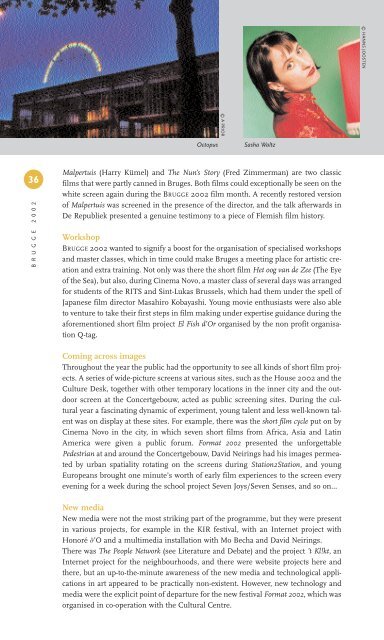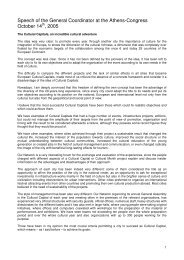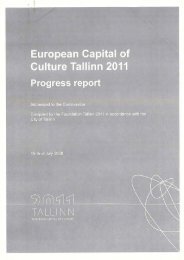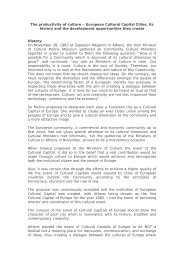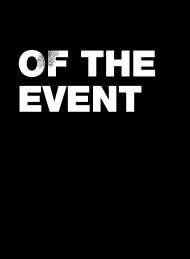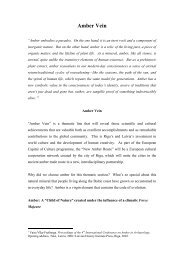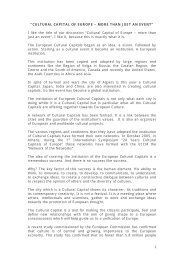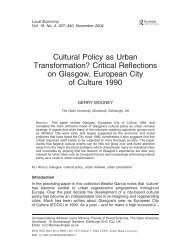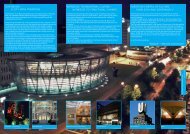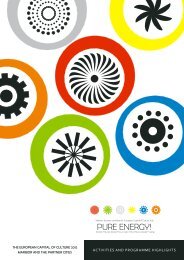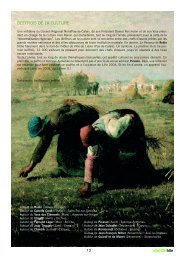Concise.pdf - Brugge Plus
Concise.pdf - Brugge Plus
Concise.pdf - Brugge Plus
- No tags were found...
You also want an ePaper? Increase the reach of your titles
YUMPU automatically turns print PDFs into web optimized ePapers that Google loves.
© HANNS JOOSTEN<br />
© A PRIOR<br />
Octopus<br />
Sasha Waltz<br />
36<br />
BRUGGE 2002<br />
Malpertuis (Harry Kümel) and The Nun’s Story (Fred Zimmerman) are two classic<br />
films that were partly canned in Bruges. Both films could exceptionally be seen on the<br />
white screen again during the BRUGGE 2002 film month. A recently restored version<br />
of Malpertuis was screened in the presence of the director, and the talk afterwards in<br />
De Republiek presented a genuine testimony to a piece of Flemish film history.<br />
Workshop<br />
BRUGGE 2002 wanted to signify a boost for the organisation of specialised workshops<br />
and master classes, which in time could make Bruges a meeting place for artistic creation<br />
and extra training. Not only was there the short film Het oog van de Zee (The Eye<br />
of the Sea), but also, during Cinema Novo, a master class of several days was arranged<br />
for students of the RITS and Sint-Lukas Brussels, which had them under the spell of<br />
Japanese film director Masahiro Kobayashi. Young movie enthusiasts were also able<br />
to venture to take their first steps in film making under expertise guidance during the<br />
aforementioned short film project El Fish d’Or organised by the non profit organisation<br />
Q-tag.<br />
Coming across images<br />
Throughout the year the public had the opportunity to see all kinds of short film projects.<br />
A series of wide-picture screens at various sites, such as the House 2002 and the<br />
Culture Desk, together with other temporary locations in the inner city and the outdoor<br />
screen at the Concertgebouw, acted as public screening sites. During the cultural<br />
year a fascinating dynamic of experiment, young talent and less well-known talent<br />
was on display at these sites. For example, there was the short film cycle put on by<br />
Cinema Novo in the city, in which seven short films from Africa, Asia and Latin<br />
America were given a public forum. Format 2002 presented the unforgettable<br />
Pedestrian at and around the Concertgebouw, David Neirings had his images permeated<br />
by urban spatiality rotating on the screens during Station2Station, and young<br />
Europeans brought one minute’s worth of early film experiences to the screen every<br />
evening for a week during the school project Seven Joys/Seven Senses, and so on…<br />
New media<br />
New media were not the most striking part of the programme, but they were present<br />
in various projects, for example in the KIR festival, with an Internet project with<br />
Honoré ∂’O and a multimedia installation with Mo Becha and David Neirings.<br />
There was The People Network (see Literature and Debate) and the project ’t Kl!kt, an<br />
Internet project for the neighbourhoods, and there were website projects here and<br />
there, but an up-to-the-minute awareness of the new media and technological applications<br />
in art appeared to be practically non-existent. However, new technology and<br />
media were the explicit point of departure for the new festival Format 2002, which was<br />
organised in co-operation with the Cultural Centre.


